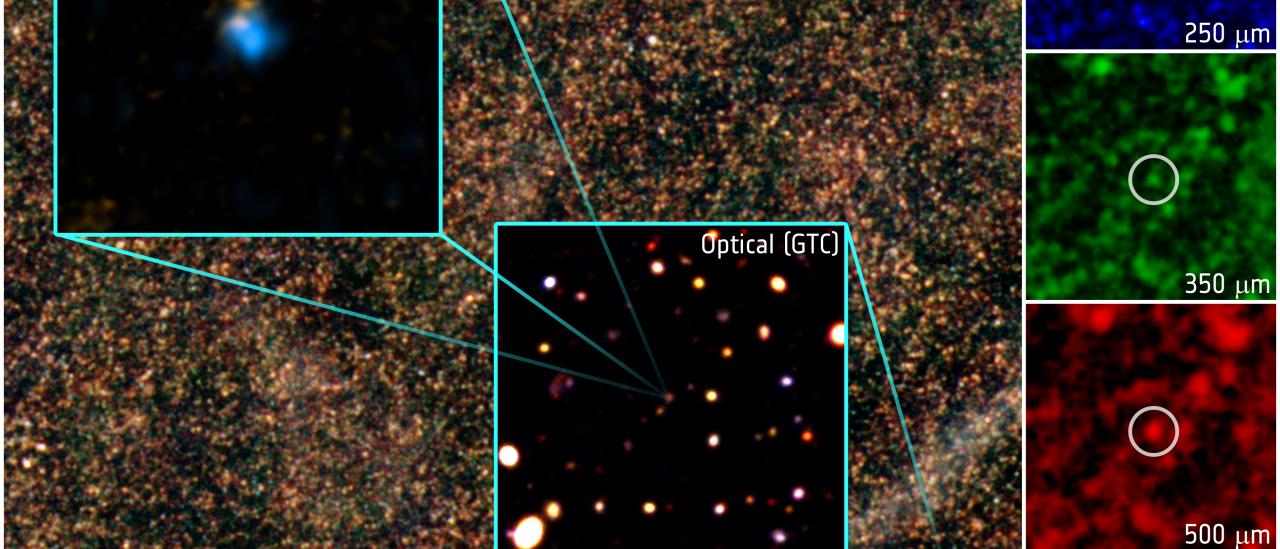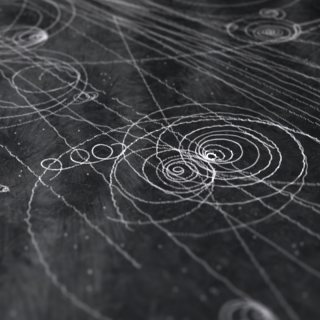Grants related:
General
This IAC research group carries out several extragalactic projects in different spectral ranges, using space as well as ground-based telescopes, to study the cosmological evolution of galaxies and the origin of nuclear activity in active galaxies. The group is a member of the international consortium which built the SPIRE instrument for the Herschel Space Observatory and of the European consortium which is developing the SAFARI instrument for the infrared space telescope SPICA of the space agencies ESA and JAXA.
The main projects in 2018 were:
a) High-redshift galaxies and quasars with far-infrared emission discovered with the Herschel Space Observatory in the HerMES and Herschel-ATLAS Key Projects.
b) Sloan Digital Sky Survey IV: BELLS GALLERY galaxies and very luminous Lyman alpha emitting galaxies.
c) Participation in the development of the SAFARI instrument, one of the European contributions to the SPICA infrared space telescope.
d) Discovery of the most distant individual star ever observed, in one of the fields of the "HST Frontier Fields".
e) Search for supernovae in distant, gravitationally lensed galaxies.
f) Several studies with GTC of absorption line systems in the line of sight to red quasars.
Members
Results
- Marques-Chaves et al. (2018) present a study of the submillimeter galaxy HLock01 at z = 2.9574, one of the brightest gravitationally lensed sources discovered in the Herschel Multi-tiered Extragalactic Survey. Detailed analysis of the high signal-to-noise ratio (SNR) rest-frame UV GTC OSIRIS spectrum shows complex kinematics of the gas.
- Rigopoulou et al. (2018) using new, Herschel spectroscopic observations of key far-infrared fine structure lines of the z ∼ 3 galaxy HLSW-01 derive gas-phase metallicities and find that the metallicities of z ∼ 3 submm-luminous galaxies are consistent with solar metallicities and that they appear to follow the mass–metallicity relation expected for z ∼ 3 systems.
- Cornachione et al. (2018) present a morphological study of 17 lensed Lyα emitter (LAE) galaxies of the BELLS GALLERY sample. The analysis combines the magnification effect of strong galaxy–galaxy lensing with the high resolution of the Hubble Space Telescope to achieve a physical resolution of ~80 pc for this 2 < z < 3 LAE sample.
- Oteo et al. (2018) report the identification of an extreme protocluster of galaxies in the early universe whose core (nicknamed Distant Red Core, DRC, because of its very red color in Herschel SPIRE bands) is formed by at least 10 dusty star-forming galaxies (DSFGs), spectroscopically confirmed to lie at z = 4.002 via detection of emission lines with ALMA and ATCA.
- Kelly et al. (2018) report the discovery of an individual star, Icarus, at redshift z = 1.49 magnified by more than × 2,000 by gravitational lensing of the galaxy cluster MACS J1149+222. Icarus is located in a spiral galaxy that is so far from Earth that its light has taken 9000 million years to reach the Earth.
Scientific activity
Related publications
-
Supernovae 2016bdu and 2005gl, and their link with SN 2009ip-like transients: another piece of the puzzle
Supernova (SN) 2016bdu is an unusual transient resembling SN 2009ip. SN 2009ip-like events are characterized by a long-lasting phase of erratic variability which ends with two luminous outbursts a few weeks apart. The second outburst is significantly more luminous (about 3 mag) than the first. In the case of SN 2016bdu, the first outburst (Event A)
Pastorello, A. et al.Advertised on:
22018 -
The ISM Properties and Gas Kinematics of a Redshift 3 Massive Dusty Star-forming Galaxy
We present CO (J = 1 → 0 3 → 2 5 → 4 10 → 9) and 1.2 kpc resolution [C II] line observations of the dusty star-forming galaxy (SFG) HXMM05—carried out with the Karl G. Jansky Very Large Array, the Combined Array for Research in Millimeter-wave Astronomy, the Plateau de Bure Interferometer, and the Atacama Large Millimeter/submillimeter Array
Leung, T. K. D. et al.Advertised on:
12019 -
Probing the high-redshift universe with SPICA: Toward the epoch of reionisation and beyond
With the recent discovery of a dozen dusty star-forming galaxies and around 30 quasars at z > 5 that are hyper-luminous in the infrared (μ L IR > 1013 L⊙, where μ is a lensing magnification factor), the possibility has opened up for SPICA, the proposed ESA M5 mid-/far-infrared mission, to extend its spectroscopic studies toward the epoch of
Egami, E. et al.Advertised on:
122018 -
SDSS J0909+4449: A large-separation strongly lensed quasar at z ˜ 2.8 with three images
We report the discovery of SDSS J0909+4449, an exceptional system consisting of a quasar at z = 2.788 strongly lensed by a group of galaxies at z ˜ 0.9 into three images separated by up to 14 arcsec based on archival data collected by the Sloan Digital Sky Survey, extended Baryon Oscillation Spectroscopic Survey, Beijing-Arizona Sky Survey, the
Shu, Y. et al.Advertised on:
112018 -
SOFIA/HAWC+ Detection of a Gravitationally Lensed Starburst Galaxy at z = 1.03
We present the detection at 89 μm (observed frame) of the Herschel-selected gravitationally lensed starburst galaxy HATLAS J1429-0028 (also known as G15v2.19) in 15 minutes with the High-resolution Airborne Wideband Camera-plus (HAWC+) onboard the Stratospheric Observatory for Infrared Astronomy (SOFIA). The spectacular lensing system consists of
Ma, J. et al.Advertised on:
92018 -
On the multiplicity of ALMA Compact Array counterparts of far-infrared bright quasars
We present ALMA Atacama Compact Array (ACA) 870 μm continuum maps of 28 infrared-bright SDSS quasars with Herschel/SPIRE detections at redshifts 2-4, the largest such sample ever observed with ALMA. The ACA detections are centred on the SDSS coordinates to within 1 ″ for about 80 per cent of the sample. Larger offsets indicate that the far-infrared
Hatziminaoglou, E. et al.Advertised on:
112018 -
Unidentified quasars among stationary objects from Gaia DR2
Here we apply a technique selecting quasar candidates purely as sources with zero proper motions in the Gaia data release 2 (DR2). We demonstrate that this approach is highly efficient toward high Galactic latitudes with ≲25% contamination from stellar sources. Such a selection technique offers very pure sample completeness, since all cosmological
Heintz, K. E. et al.Advertised on:
72018 -
A quasar hiding behind two dusty absorbers. Quantifying the selection bias of metal-rich, damped Lyα absorption systems
The cosmic chemical enrichment as measured from damped Lyα absorbers (DLAs) will be underestimated if dusty and metal-rich absorbers have evaded identification. Here we report the discovery and present the spectroscopic observations of a quasar, KV-RQ 1500-0031, at z = 2.520 reddened by a likely dusty DLA at z = 2.428 and a strong Mg II absorber at
Heintz, K. E. et al.Advertised on:
72018 -
The Fourteenth Data Release of the Sloan Digital Sky Survey: First Spectroscopic Data from the Extended Baryon Oscillation Spectroscopic Survey and from the Second Phase of the Apache Point Observatory Galactic Evolution Experiment
The fourth generation of the Sloan Digital Sky Survey (SDSS-IV) has been in operation since 2014 July. This paper describes the second data release from this phase, and the 14th from SDSS overall (making this Data Release Fourteen or DR14). This release makes the data taken by SDSS-IV in its first two years of operation (2014–2016 July) public
Abolfathi, B. et al.Advertised on:
42018 -
Extreme magnification of an individual star at redshift 1.5 by a galaxy-cluster lens
Galaxy-cluster gravitational lenses can magnify background galaxies by a total factor of up to 50. Here we report an image of an individual star at redshift z = 1.49 (dubbed MACS J1149 Lensed Star 1) magnified by more than ×2,000. A separate image, detected briefly 0.26″ from Lensed Star 1, is probably a counterimage of the first star demagnified
Kelly, Patrick L. et al.Advertised on:
42018 -
An Extreme Protocluster of Luminous Dusty Starbursts in the Early Universe
We report the identification of an extreme protocluster of galaxies in the early universe whose core (nicknamed Distant Red Core, DRC, because of its very red color in Herschel SPIRE bands) is formed by at least 10 dusty star-forming galaxies (DSFGs), spectroscopically confirmed to lie at {z}spec}=4.002 via detection of [C I](1–0), 12CO(6–5), 12CO
Oteo, I. et al.Advertised on:
32018 -
The Strong Gravitationally Lensed Herschel Galaxy HLock01: Optical Spectroscopy Reveals a Close Galaxy Merger with Evidence of Inflowing Gas
The submillimeter galaxy (SMG) HERMES J105751.1+573027 (hereafter HLock01) at z = 2.9574 ± 0.0001 is one of the brightest gravitationally lensed sources discovered in the Herschel Multi-tiered Extragalactic Survey. Apart from the high flux densities in the far-infrared, it is also extremely bright in the rest-frame ultraviolet (UV), with a total
Gavazzi, Raphael et al.Advertised on:
22018 -
Photometric survey, modelling, and scaling of long-period and low-amplitude asteroids
Context. The available set of spin and shape modelled asteroids is strongly biased against slowly rotating targets and those with low lightcurve amplitudes. This is due to the observing selection effects. As a consequence, the current picture of asteroid spin axis distribution, rotation rates, radiometric properties, or aspects related to the
Marciniak, A. et al.Advertised on:
22018 -
A precise measurement of the magnetic field in the corona of the black hole binary V404 Cygni
Observations of binary stars containing an accreting black hole or neutron star often show x-ray emission extending to high energies (>10 kilo–electron volts), which is ascribed to an accretion disk corona of energetic particles akin to those seen in the solar corona. Despite their ubiquity, the physical conditions in accretion disk coronae remain
Dallilar, Y. et al.Advertised on:
122017 -
SNhunt151: an explosive event inside a dense cocoon
SNhunt151 was initially classified as a supernova (SN) impostor (nonterminal outburst of a massive star). It exhibited a slow increase in luminosity, lasting about 450 d, followed by a major brightening that reaches MV ≈ -18 mag. No source is detected to MV ≳ -13 mag in archival images at the position of SNhunt151 before the slow rise. Low-to-mid
Elias-Rosa, N. et al.Advertised on:
42018 -
The BOSS Emission-line Lens Survey. V. Morphology and Substructure of Lensed Lyα Emitters at Redshift Z ≈ 2.5 in the BELLS GALLERY
We present a morphological study of the 17 lensed Lyα emitter (LAE) galaxies of the Baryon Oscillation Spectroscopic Survey Emission-Line Lens Survey (BELLS) for the GALaxy-Lyα EmitteR sYstems (BELLS GALLERY) sample. This analysis combines the magnification effect of strong galaxy–galaxy lensing with the high resolution of the Hubble Space
Cornachione, M. A. et al.Advertised on:
22018 -
280 one-opposition near-Earth asteroids recovered by the EURONEAR with the Isaac Newton Telescope
Context. One-opposition near-Earth asteroids (NEAs) are growing in number, and they must be recovered to prevent loss and mismatch risk, and to improve their orbits, as they are likely to be too faint for detection in shallow surveys at future apparitions. Aims: We aimed to recover more than half of the one-opposition NEAs recommended for
Vaduvescu, O. et al.Advertised on:
12018 -
On the far-infrared metallicity diagnostics: applications to high-redshift galaxies
In an earlier paper we modelled the far-infrared emission from a star-forming galaxy using the photoionization code CLOUDY and presented metallicity sensitive diagnostics based on far-infrared fine structure line ratios. Here, we focus on the applicability of the [O III] 88 μm/[N II] 122 μm line ratio as a gas-phase metallicity indicator in high
Rigopoulou, D. et al.Advertised on:
12018 -
The 13th Data Release of the Sloan Digital Sky Survey: First Spectroscopic Data from the SDSS-IV Survey Mapping Nearby Galaxies at Apache Point Observatory
The fourth generation of the Sloan Digital Sky Survey (SDSS-IV) began observations in 2014 July. It pursues three core programs: the Apache Point Observatory Galactic Evolution Experiment 2 (APOGEE-2), Mapping Nearby Galaxies at APO (MaNGA), and the Extended Baryon Oscillation Spectroscopic Survey (eBOSS). As well as its core program, eBOSS
Albareti, F. D. et al.Advertised on:
122017 -
The most distant, luminous, dusty star-forming galaxies: redshifts from NOEMA and ALMA spectral scans
We present 1.3- and/or 3-mm continuum images and 3-mm spectral scans, obtained using Northern Extended Millimeter Array (NOEMA) and Atacama Large Millimeter Array (ALMA), of 21 distant, dusty, star-forming galaxies. Our sample is a subset of the galaxies selected by Ivison et al. on the basis of their extremely red far-infrared (far-IR) colours and
Fudamoto, Y. et al.Advertised on:
122017



